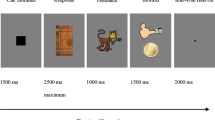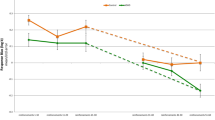Abstract
A paired-associate learning (PAL) test was administered to 22 community volunteers without disruptive disorders and 197 children (7.5–13.5 years-old) presenting with the inattentive and combined subtypes of attention-deficit/hyperactivity disorder (ADHD) either in combination with or without oppositional defiant disorder (ODD). Participants were screened for learning disorders. In comparison to non-ADHD participants, children with ADHD achieved worse PAL and made errors rated as more acoustically and less semantically similar to the correct paired associates. These deficits were not related to hyperactivity–impulsivity or comorbid ODD. These results suggest that ADHD children are less competent at PAL and use less efficient learning strategies than their non-ADHD peers.
Similar content being viewed by others
REFERENCES
Ackerman, R. T., Anhalt, J. M., Dykman, R. A., & Holcomb, P. J. (1986). Effortful processing deficits in children with reading and/or attention disorders. Brain and Cognition, 5, 22–40.
Agronin, M. E., Holahan, J. M., Shaywitz, B. A., & Shaywitz, S. E. (1992). The Multi-Grade Inventory for Teachers (MIT): Scale development, reliability, and validity of an instrument to assess children with attentional deficits and learning disabilities. In S. E. Shaywitz & B. A. Shaywitz (Eds.), Attention deficit disorder comes of age: Toward the twenty-first century (pp. 89–116). Austin, TX: Pro-ed.
American Psychiatric Association. (1994). Diagnostic and statistical manual of mental disorders (4th ed.). Washington, DC: Author.
August, G. J. (1987). Production deficiencies in free recall: A comparison of hyperactive, learning-disabled, and normal children. Journal of Abnormal Child Psychology, 15, 429–440.
Barber, M. A., Milich, R., & Welsh, R. (1996). Effects of reinforcement schedule and task difficulty on the performance of Attention Deficit Hyperactivity disordered and control boys. Journal of Clinical Child Psychology, 25, 66–76.
Barkley, R. A. (1997a). ADHD and the nature of self-control. New York: Guilford Press.
Barkley, R. A. (1997b). Behavioral inhibition, sustained attention, and executive functions: Constructing a unifying theory of ADHD. Psychological Bulletin, 121, 65–94.
Barkley, R. A. (1998). Attention-deficit hyperactivity disorder (2nd ed.). New York: Guilford Press.
Barkley, R. A., DuPaul, G. J., & McMurray, B. (1990). Comprehensive evaluation of attention deficit disorder with and without hyperactivity as defined by research criteria. Journal of Consulting and Clinical Psychology, 58, 775–789.
Barkley, R. A., DuPaul, G. J., & McMurray, B. (1991). Attention deficit disorder with and without hyperactivity: Clinical response to three dose levels of methylphenidate. Pediatrics, 87, 519–531.
Barkley, R. A., Grodzinsky, G., & DuPaul, G. J. (1992). Frontal lobe functions in attention deficit disorder with and without hyperactivity: A review and research report. Journal of Abnormal Child Psychology, 20, 163–188.
Barkley, R. A., McMurray, M. B., Edelbrock, C. S., & Robbins, K. (1989). The response of aggressive and non-aggressive ADHD children to two doses of methylphenidate. Journal of the American Academy of Child and Adolescent Psychiatry, 28, 873–881.
Benezra, E., & Douglas, V. I. (1988). Short-term serial recall in ADDH, normal, and reading-disabled boys. Journal of Abnormal Child Psychology, 16, 511–525.
Beuhring, T., & Kee, D. W. (1987). Developmental relationships among metamemory, elaborative strategy use, and associative memory. Journal of Experimental Child Psychology, 44, 377–400.
Borkowski, J. G., & Burke, J. E. (1996). Theories, models, and measurements of executive functioning. In G. R. Lyon & N. A. Krasnegor (Eds.), Attention, memory, and executive function (pp. 235–261). Baltimore: Paul H. Brookes.
Cantwell, D. P., & Baker, L. (1992). Association between attention deficit-hyperactivity disorder and learning disorder. In S. E. Shaywitz & B. A. Shaywitz (Eds.), Attention deficit disorder comes of age: Toward the twenty-first century (pp. 145–164). Austin, TX: Pro-ed.
Cohen, J. (1988). Statistical power analysis for the behavioral sciences (2nd ed.). Hillsdale, NJ: Erlbaum.
Conners, C. K., Rothschild, G., Eisenberg, L., Schwartz, L. S., & Robinson, E. (1969). Dextroamphetamine sulfate in children with learning disorders. Archives of General Psychiatry, 21, 182–190.
Conte, R., Kinsbourne, M., Swanson, J., Zirk, H., & Samuels, M. (1986). Presentation rate effects on paired associate learning by attention deficit disordered children. Child Development, 57, 681–687.
Craik, F. I., & Lockhart, R. S. (1972). Levels of processing: A framework of memory research. Journal of Verbal Learning and Verbal Behavior, 11, 671–684.
Dalby, J. T., Kinsbourne, M., Swanson, J. M., & Sobol, M. P. (1977). Hyperactive children's underuse of learning time: Correction by stimulant treatment. Child Development, 48, 1448–1453.
Douglas, V. I. (1988). Cognitive deficits in children with attention deficit disorder with hyperactivity. In L. M. Bloomingdale & J. A. Sergeant (Eds.), Attention deficit disorder (Vol. 5, pp. 65–81). Oxford: Pergamon Press.
Douglas, V. I., Barr, R. G., Amin, K., O'Neill, M. E., & Britton, B. G. (1988). Dosage effects and individual responsivity to methylphenidate in attention deficit disorder. Journal of Child Psychology and Psychiatry, 29, 453–475.
Douglas, V. I., Barr, R. G., O'Neill, M. E., & Britton, B. G. (1986). Short term effects of methylphenidate on the cognitive, learning, and academic performance of children with attention deficit disorder in the laboratory and the classroom. Journal of Child Psychology and Psychiatry, 27, 191–211.
Douglas, V. I., & Benezra, E. (1990). Supraspan verbal memory in attention deficit disorder with hyperactivity, normal, and reading-disabled boys. Journal of Abnormal Child Psychology, 18, 617–638.
Dykman, R. A., & Ackerman, P. T. (1992). Attention deficit disorder and specific reading disability: Separate but often overlapping disorders. In S. E. Shaywitz & B. A. Shaywitz (Eds.), Attention deficit disorder comes of age: Toward the twenty-first century (pp. 165–183). Austin, TX: Pro-ed.
Epstein, M., Shaywitz, S. E., Shaywitz, B. A., & Woolsten, J. (1992). The boundaries of attention deficit disorder. In S. E. Shaywitz & B. A. Shaywitz (Eds.), Attention deficit disorder comes of age: Toward the twenty-first century (pp. 197–217). Austin, TX: Pro-ed.
Fletcher, J. M., Francis, D. J., Shaywitz, S. E., Lyon, G. R., Foorman, B. R., Steubing, K. K., & Shaywitz, B. A. (1998). Intelligent testing and the discrepancy model for children with learning disabilities. Learning Disabilities Research and Practice, 113, 186–203.
Fletcher, J. M., Shaywitz, S. E., Shankweiler, D. P., Katz, L., Liberman, I. Y., Stuebing, K. K., Francis, D. J., Fowler, A. E., & Shaywitz, B. A. (1994). Cognitive profiles of reading disability: Comparisons of discrepancy and low achievement definitions. Journal of Educational Psychology, 86, 6–23.
Gathercole, S. E., Hitch, G. J., Service, E., & Martin, A. J. (1997). Phonological short-term memory and new word learning in children. Developmental Psychology, 33, 966–979.
Halperin, J., O'Brien, J., Newcorn, J., Healey, J., Pascualvaca, D., Wolf, L., & Young, J. (1990). Validation of hyperactive, aggressive, and mixed hyperactive/aggressive childhood disorders: A research note. Journal of Child Psychology and Psychiatry, 31, 455–459.
Holbrow, P. L., & Berry, P. S. (1986). Hyperactivity and learning disabilities. Journal of Learning Disabilities, 19, 426–431.
Kinsbourne, M. (1977). The mechanism of hyperactivity. In M. Blain, I. Papin, & M. Kinsbourne (Eds.), Topics in child neurology (pp. 289–306). New York: Spectrum.
Kintsch, W. (1970). Learning, memory, and conceptual processes. New York: Wiley.
Klorman, R., Brumaghim, J. T., Fitzpatrick, P. A., Borgstedt, A. D., & Strauss, J. (1994). Clinical and cognitive effects of methylphenidate on children with attention deficit disorder as a function of aggression/oppositionality and age. Journal of Abnormal Psychology, 104, 206–221.
Klorman, R., Brumaghim, J. T., Salzman, L. F., Strauss, J., Borgstedt, A. D., McBride, M. C., & Loeb, S. (1988). Effects of methylphenidate on attention-deficit hyperactivity disorder with and without aggressive/noncompliant features. Journal of Abnormal Psychology, 97, 413–422.
Klorman, R., Hazel-Fernandez, L. A., Shaywitz, S. E., Fletcher, J. M., Marchione, K. E., Holahan, J. M., Stuebing, K. K., & Shaywitz, B. A. (in press). Executive functioning deficits in Attention Deficit/Hyperactivity Disorder are independent of Oppositional/Defiant or Reading Disorder. Journal of the American Academy of Child and Adolescent Psychiatry.
Lahey, B., & Carlson, C. (1991). Validity of diagnostic category of attention deficit disorder without hyperactivity: A review of the literature. Journal of Learning Disabilities, 24, 110–120.
Loney, J. (1987). Hyperactivity and aggression in the diagnosis of attention deficit disorder. In B. Lahey & A. Kazdin (Eds.), Advances in clinical child psychology (pp. 99–135). New York: Plenum Press.
Moffitt, T. E., & Henry, B. (1989). Neuropsychological assessment of executive functions in self-reported delinquents. Development and Psychopathology, 1, 105–118.
Moffitt, T. E., & Silva, P. A. (1988). Self-reported delinquency, neuropsychological deficit, and history of attention deficit disorder. Journal of Abnormal Child Psychology, 16, 553–569.
Myers, J. L., & Well, A. D. (1995). Research design and statistical analysis. Hillsdale, NJ: Erlbaum.
O'Neill, M. E., & Douglas, V. I. (1991). Study strategies and story recall in attention deficit disorder and reading disability. Journal of Abnormal Child Psychology, 19, 671–692.
O'Neill, M. E., & Douglas, V. I. (1996). Rehearsal strategies and recall performance in boys with and without attention deficit hyperactivity disorder. Journal of Pediatric Psychology, 21, 73–88.
Pennington, B. F., & Ozonoff, S. (1996). Executive functions and developmental psychopathology. Journal of Child Psychology and Psychiatry, 37, 51–87.
Rapport, M., Stoner, G., DuPaul, G. J., Birmingham, B. K., & Tucker, S. (1985). Methylphenidate in hyperactive children: Differential effects of dose on academic, learning, and social behavior. Journal of Abnormal Child Psychology, 13, 227–244.
Schneider, W., & Bjorklund, D. F. (1998). Memory. In W. Damon (Ed.), Handbook of child psychology (5th ed.), pp. 467–521. New York: Wiley.
Shaffer, D., Fisher, P., Dulcan, M. K., Davies, M., Piacentini, J., Schwab-Stone, M. E., Lahey, B. B., Bourdon, K., Jensen, P. S., Bird, H. R., Canino, G., & Regier, D. A. (1996). The NIMH Diagnostic Interview Schedule for Children Version 2.3 (DISC 2.3): Description, acceptability, prevalence rates, and performance in the MECA study. Journal of the American Academy of Child and Adolescent Psychiatry, 35, 865–877.
Shaywitz, S. E., Escobar, M. D., Shaywitz, B. A., Fletcher, J. M., & Makuch, R. (1992). Evidence that dyslexia may represent the lower tail of a normal distribution of reading disability. New England Journal of Medicine, 326, 145–150.
Stevenson, H. W., Hale, G., Klein, R. E., & Miller, L. K. (1968). Interrelations and correlates in children's learning and problem solving. Monographs of the Society for Research in Child Development, 33, (7, Serial No. 123).
Swanson, J., Kinsbourne, M., Roberts, W., & Zucker, M. A. (1978). Time-response analysis of the effect of stimulant medication on the learning ability of children referred for hyperactivity. Pediatrics, 61, 21–29.
Thorndike, E. L., & Lorge, I. (1944). The teacher's word book of 30,000 words. New York: Teacher's College, Columbia University.
Wechsler, D. (1974). The Wechsler Intelligence Scale for Children—Revised. New York: Psychological Corporation.
Weingartner, H., Rapoport, J. L., Buchsbaum, M. S., Bunney, W. E., Ebert, M. H., Mikkelsen, E. J., & Caine, E. D. (1980). Cognitive processes in normal and hyperactive children and their response to amphetamine treatment. Journal of Abnormal Psychology, 89, 25–37.
Woodcock, R. (1978). Development and standardization of the Woodcock-Johnson Psychoeducational Battery. Allen, TX: DLN Teaching Services.
Zeaman, D., & House, B. J. (1967). The relation of IQ and learning. In R. M. Gagne (Ed.), Learning and individual differences (pp. 192–212). Columbus, OH: Merrill.
Author information
Authors and Affiliations
Rights and permissions
About this article
Cite this article
Chang, H.T., Klorman, R., Shaywitz, S.E. et al. Paired-Associate Learning in Attention-Deficit/Hyperactivity Disorder as a Function of Hyperactivity-Impulsivity and Oppositional Defiant Disorder. J Abnorm Child Psychol 27, 237–245 (1999). https://doi.org/10.1023/A:1021956507983
Issue Date:
DOI: https://doi.org/10.1023/A:1021956507983




